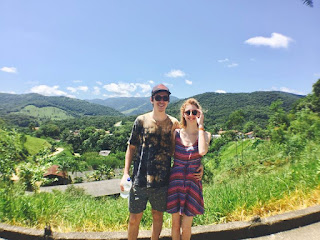Our Experience as Tree Inventory Volunteers in the Atlantic Forest
We’ve only stayed at IPBio for a short
period, just one month, but this blog-post aims to share some of our
experiences from that perspective, and talk about the general process of
sorting out a Volunteering stay here in Reserva Betary.
Firstly, what’s the place like. We’ve done
similar types of programmes in different parts of the world and we can safely
say that the accommodation and ease of arrival is the most comfortable we have
experienced. And fortunately for potential volunteers, this is only going to
get better. During our stay in May 2017, construction was under way for a new
and bigger house to expand the Volunteer program. The setting is idyllic if you
like the natural state of things, as the Reserve is in the heart of the remains
of the Mata-Atlantica in the modern state of Sao Paulo, with the rustling of
trees, the rushing river and bird calls being the sounds of the day.
Foremost IPBio is a research facility aimed
at documenting and evaluating the biodiversity of the area directly surrounding
the main centre and living facilities, and so each volunteer arrives with a
pre-determined understanding of the projects they are going to be involved in.
This was great as the most important thing is volunteering with an actual
purpose, and contributing positively to ongoing projects, no matter what the
intensity of day to day activities are.
Our project was the tree inventory and phenological
mapping of the trees along the trails of the reserve, which aims to be a
concurrent project associated with the opening of a bird release centre opening
nearby. Most days we’d be out in the forest along the Reserve trails
identifying, measuring and taking bark/foliage samples of all the trees marked
for the inventory. Despite neither of us being from a forest or biology
background, we enjoyed this immensely, learning and doing lots of new things
and practices along the way.
Despite our short stay, we managed to get a
feel for the reserve and leave with a greater understanding and appreciation of
the significance of the diversity of tree species and how every part of a tree
can permeate and preserve our everyday lives. As a volunteering experience, it
is one that we would recommend for any budding biologist who wants to get some
field experience, or general persons that enjoy the outdoors and would like to
contribute to conservation activities.
Ate mais!
Written by: David (volunteer from the UK) and Hanan (volunteer from Brazil)





Comments
Post a Comment